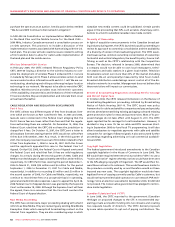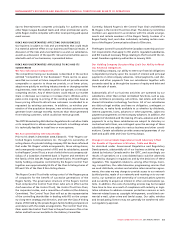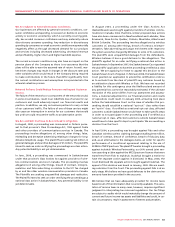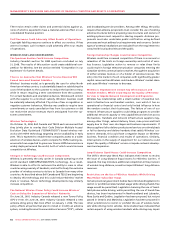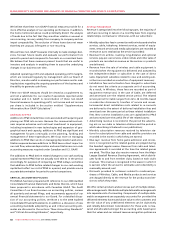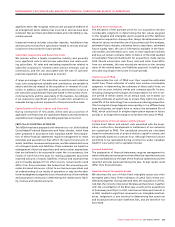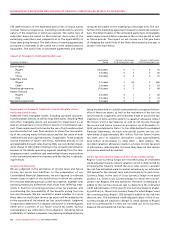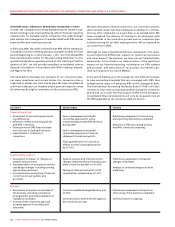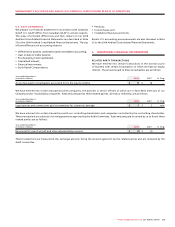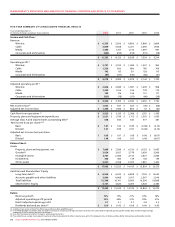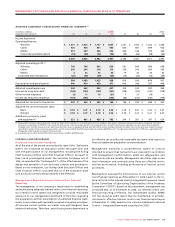Rogers 2008 Annual Report Download - page 72
Download and view the complete annual report
Please find page 72 of the 2008 Rogers annual report below. You can navigate through the pages in the report by either clicking on the pages listed below, or by using the keyword search tool below to find specific information within the annual report.
68 ROGERS COMMUNICATIONS INC. 2008 ANNUAL REPORT
MANAGEMENT’S DISCUSSION AND ANALYSIS OF FINANCIAL CONDITION AND RESULTS OF OPERATIONS
We believe that these non-GAAP financial measures provide for a
more effective analysis of our operating performance. In addition,
the items mentioned above could potentially distort the analysis
of trends due to the fact that they are either volatile or unusual or
non-recurring, can vary widely from company-to-company and can
impair comparability. The exclusion of these items does not mean
that they are unusual, infrequent or non-recurring.
We use these non-GAAP measures internally to make strategic deci-
sions, forecast future results and evaluate our performance from
period-to-period and compared to forecasts on a consistent basis.
We believe that these measures present trends that are useful to
investors and analysts in enabling them to assess the underlying
changes in our business over time.
Adjusted operating profit and adjusted operating profit margins,
which are reviewed regularly by management and our Board of
Directors, are also useful in assessing our performance and in mak-
ing decisions regarding the ongoing operations of the business and
the ability to generate cash flows.
These non-GAAP measures should be viewed as a supplement to,
and not a substitute for, our results of operations reported under
Canadian and U.S. GAAP. A reconciliation of these non-GAAP
financial measures to operating profit, net income and net income
per share is included in the section entitled “Supplementary
Information: Non-GAAP Calculations”.
Additions to PP&E
Additions to PP&E include those costs associated with acquiring and
placing our PP&E into service. Because the communications busi-
ness requires extensive and continual investment in equipment,
including investment in new technologies and expansion of geo-
graphical reach and capacity, additions to PP&E are significant and
management focuses continually on the planning, funding and
management of these expenditures. We focus more on managing
additions to PP&E than we do on managing depreciation and amor-
tization expense because additions to PP&E have a direct impact on
our cash flow, whereas depreciation and amortization are non-cash
accounting measures required under Canadian and U.S. GAAP.
The additions to PP&E before related changes to non-cash working
capital represent PP&E that we actually took title to in the period.
Accordingly, for purposes of comparing our PP&E outlays, we believe
that additions to PP&E before related changes to non-cash working
capital best reflect our cost of PP&E in a period, and provide a more
accurate determination for period-to-period comparisons.
CRITICAL ACCOUNTING POLICIES
This MD&A has been prepared with reference to our 2008 Audited
Consolidated Financial Statements and Notes thereto, which have
been prepared in accordance with Canadian GAAP. The Audit
Committee of our Board reviews our accounting policies, reviews
all quarterly and annual filings, and recommends approval of our
annual financial statements to our Board. For a detailed discus-
sion of our accounting policies, see Note 2 to the 2008 Audited
Consolidated Financial Statements. In addition, a discussion of new
accounting standards adopted by us and critical accounting esti-
mates are discussed in the sections “New Accounting Standards”
and “Critical Accounting Estimates”, respectively.
Revenue Recognition
Revenue is categorized into the following types, the majority of
which are recurring in nature on a monthly basis from ongoing
relationships, contractual or otherwise, with our subscribers:
• Monthlysubscriberfeesinconnectionwithwirelessandwireline
services, cable, telephony, Internet services, rental of equip-
ment, network services and media subscriptions are recorded as
revenue on a pro rata basis as the service is provided;
• Revenuefromairtime,roaming,long-distanceandoptional
services, pay-per-use services, video rentals and other sales of
products are recorded as revenue as the services or products
are delivered;
• Revenue fromthesaleofwireless and cableequipmentis
recorded when the equipment is delivered and accepted by
the independent dealer or subscriber in the case of direct
sales. Equipment subsidies related to new and existing sub-
scribers are recorded as a reduction of equipment revenues;
• Installationfeesandactivationfeeschargedtosubscribers
do not meet the criteria as a separate unit of accounting.
As a result, in Wireless, these fees are recorded as part of
equipment revenue and, in the case of Cable, are deferred
and amortized over the related service period. The related
service period for Cable ranges from 26 to 48 months, based
on subscriber disconnects, transfers of service and moves.
Incremental direct installation costs related to re-connects
are deferred to the extent of deferred installation fees and
amortized over the same period as these related installation
fees. New connect installation costs are capitalized to PP&E
and amortized over the useful life of the related assets;
• Advertisingrevenueisrecordedintheperiodtheadvertis-
ing airs on our radio or television stations and the period in
which advertising is featured in our publications;
• Monthly subscription revenues received by television sta-
tions for subscriptions from cable and satellite providers are
recorded in the month in which they are earned;
• BlueJays’revenuefromhomegameadmissionandconces-
sions is recognized as the related games are played during
the baseball regular season. Revenue from radio and televi-
sion agreements is recorded at the time the related games
are aired. The Blue Jays also receive revenue from the Major
League Baseball Revenue Sharing Agreement, which distrib-
utes funds to and from member clubs, based on each club’s
revenues. This revenue is recognized in the season in which it
is earned, when the amount is estimable and collectibility is
reasonably assured; and
• Discountsprovidedto customersrelatedtocombinedpur-
chases of Wireless, Cable, and Media products and services
are charged directly to the revenue for the products and ser-
vices to which they relate.
We offer certain products and services as part of multiple deliver-
able arrangements. We divide multiple deliverable arrangements
into separate units of accounting. Components of multiple deliv-
erable arrangements are separately accounted for provided the
delivered elements have stand-alone value to the customers and
the fair value of any undelivered elements can be objectively
and reliably determined. Consideration for these units is mea-
sured and allocated amongst the accounting units based upon
their fair values and our relevant revenue recognition policies are


